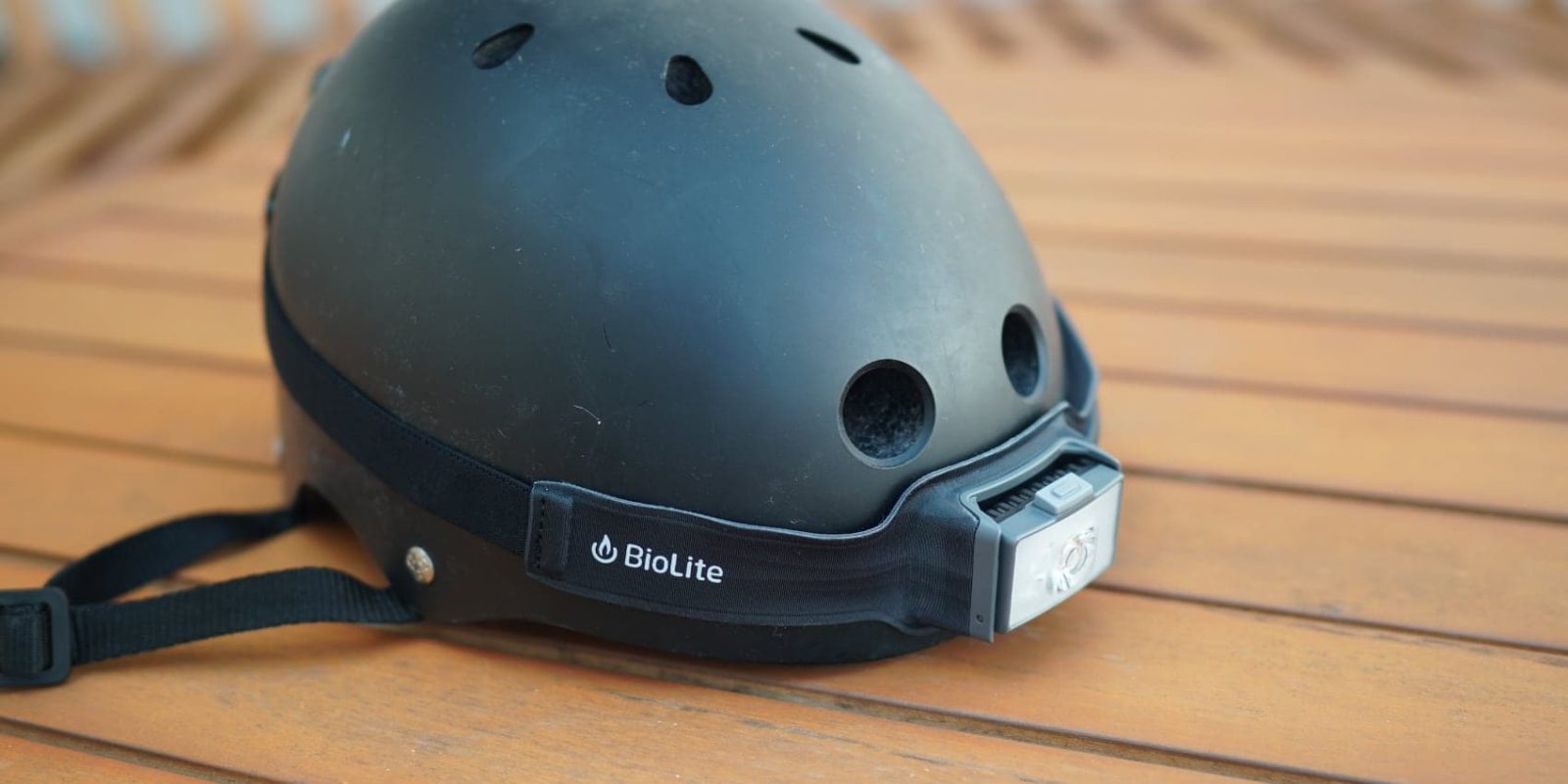
The best way I’ve found to reduce or eliminate car usage in a city is with an electric bike. But in the winter, nights come at you early, and it’s more important than ever to ensure that as cyclists, we’re visible to the biggest danger on the roads: car drivers. I’ve been testing out a new headlamp called the BioLite HeadLamp 800 Pro that isn’t specifically meant for cyclists, but has proven perfect for me as a way to add both front and rear LED lighting to pretty much any helmet.
That’s a major part of this series, often finding cool gear that might not have been originally meant for us as e-bikers, but that works great and can be co-opted to make car-replacing electric bikes even better and easier to use.
I love helmets that have built-in LED illumination. While most electric bikes come with their own headlights, having a higher-mounted LED makes riders even more visible. These are usually lower power be-seen lights, though the ability to actually shine light in an area you want to quickly glance at is a major superpower for those early winter nights on poorly lit trails and bike lanes. Light is good, but directional light is great.
The downside of helmet-based lights is that you’re limited to the few manufacturers that actually do incorporate them, and even then the lights are usually fairly weak. Even though there are great options out there (I love the helmet offered by Electric Bike Company for its 100% customizable paint job and built-in LED lighting), adding lighting to your own helmet can save money and give you a wider range of options for helmet features. I’ve been testing out the HeadLamp 800 Pro from BioLite for use as a cycling light, and this thing is darn near perfect for riding at night or in other low-visibility scenarios like rain/snow storms.
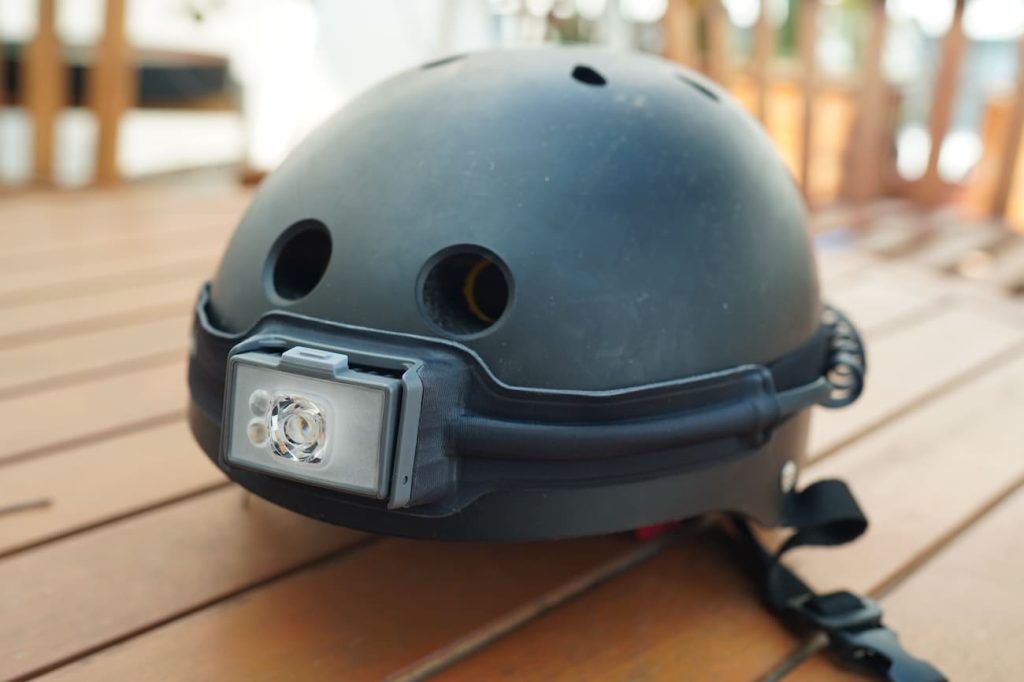
Like most headlamps, it’s easy to adjust it to fit just about any helmet, instantly giving you old-school mining helmet vibes. It’s also got a coating inside the bands that makes it lock onto the shell without sliding around like an old underwear waistband. I don’t ride without a helmet often, but it’s still comfortable right on your head or over a knit hat, if you like to go sans brain bucket.
Unlike my hiking headlamps that have been dancing around in my camping gear bags for nearly a decade, this thing is much lower profile so it doesn’t add a lot of bulk or momentum when turning my head around while cycling. I do a lot of shoulder checks, so not having something heavy out for in front of my face is important to me.
As far as lighting levels, there are plenty. The low brightness mode is just 5 lumens, so I don’t really use that one except when all I want is to be seen by drivers. Usually I like having more light thrown out in front of me to serve as my own headlight. The 250-lumen medium mode and 500-lumen high mode are great for everyday cycling use. There’s an even higher 800-lumen mode, but that’s more than I need and I don’t want to blind drivers, either. And it’s easy to adjust between the front spot light modes, flood light, strobe light, and dimming options.
There’s also a red light on the rear that is perfect for cyclists like us, as it gives you a high-mounted tail light – something you’ll almost never see on a bike. Lower-mounted e-bike lights under the seat are often blocked by backpacks or winter jackets that hang lower, so a high-mounted tail light on the back of your head is a great idea. That one can also either be full-on flood light or a strobe, depending on how you prefer. I like solid lights as opposed to strobes, and your head motion will likely give the rear LED enough movement to catch drivers attention, but the strobe option is there if you like it. The front light also has a red option, which is great for when I’m camping, but I wouldn’t use that front red mode while riding as it could cause some directional confusion for other drivers and is really meant as a night vision-preservation tool outside of cycling. For camping and hiking, it’s great.
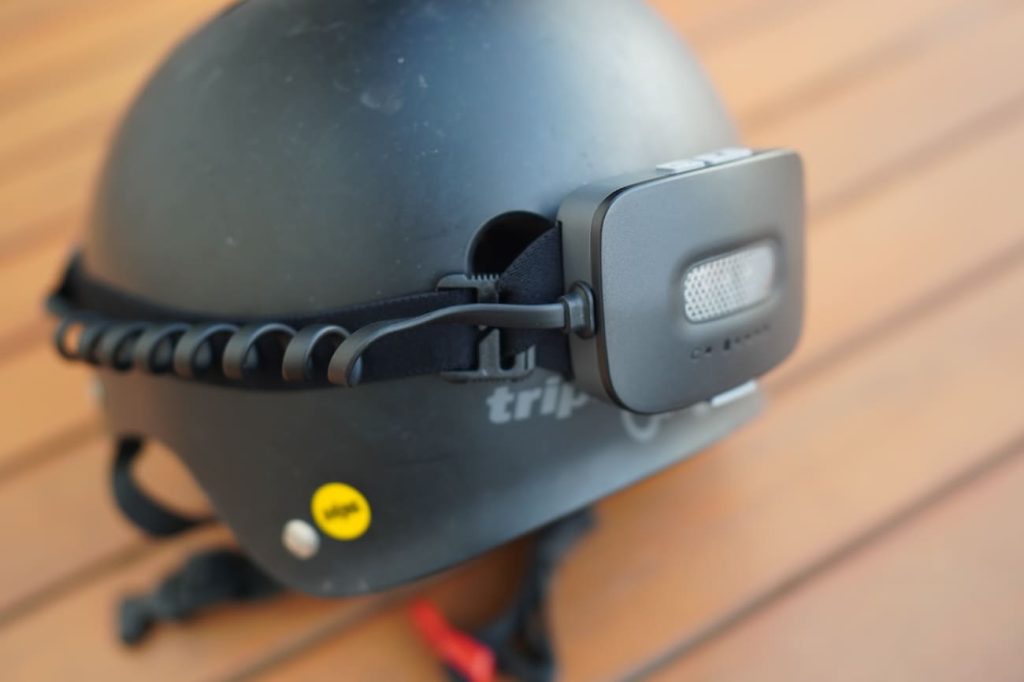
As far as run-time, I find that the built-in battery is longer than any typical commuting trip I’ll ever make. The say medium power lasts four hours of constant use and high power lasts for two hours on constant use, which I haven’t really measured because I just try to charge it around once a week to not get too low. It uses a micro-USB port to charge, which I wish was USB-C since I have more of those cords laying around, but it’s not a deal breaker for me.
If you want to keep the power up high and still have an even longer run-time than several hours, the BioLite HeadLamp 800 Pro has pass-through charging that allows you to run the light from a powerbank like you’d use to charge your phone.
I’ve tried it with the Charge 80 PD battery that BioLite sent me with the headlamp, which has massive capacity yet still fits in your pocket. It’s barely larger than a smartphone, yet can recharge a smartphone around 5 times. You could even use it to charge a laptop (which I have also done in a pinch while traveling) with the 18W USB-C PD port. I like my gear to be multi-use, and I try to avoid carrying single-use tools on principle whenever possible. So a power bank that can run my headlight, charge my phone, or come on flights with me to keep my laptop charged is a major force multiplier. (With a note towards travel, I once had to talk my way into not getting my 110Wh powerbank confiscated in a German airport, so this 75Wh power bank is a lot more airline-friendly in countries with 100Wh flight-approved battery limits).
When used with my headlamp, the Charge 80 PD powers the light with a “Run Forever” cord that includes a band clip so that the USB port isn’t put under stress while connected. That means I can keep the battery in my pocket and still have it powering or charging the headlamp. In practice, I tried this to test it out and it works well, but I’m never biking for more than a few hours in a row at night, so I haven’t really needed to run the headlamp off auxiliary power in a real-world use case – at least not yet. But if you’re taking it on a night hike then I can absolutely see that scenario being useful.
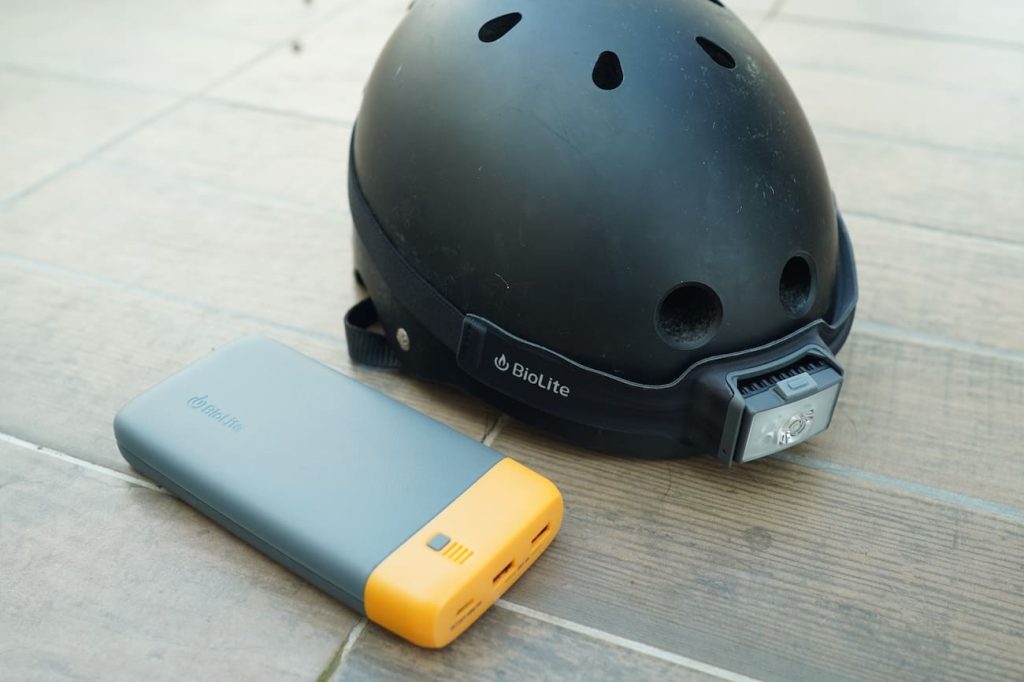
The only downside that jumps out at me is the price, since the BioLite HeadLamp 800 Pro is rather expensive at $99.95. Since I’m used to my 10-year-old camping headlamp from REI that owes me nothing, that seems steep initially. But then again, this thing lasts so much longer, doesn’t require AAA batteries, is around 8x as powerful, is built out of aluminum for long-lasting ruggedness, and gives me a rear red LED light that’s perfect for cyclists.
It’s also not light, at 5.3 oz or around 150g. That’s a third of a pound or so. But I find that I don’t notice the extra weight after a minute or two, and the low-profile design helps it stay close to the helmet.
BioLite also has other models with some of the same features, though not quite as tricked out, for significantly less. So if you like the idea of adding front and rear LED lights to your helmet and can get away with fewer lumens or other features, they’ve got other options there too.
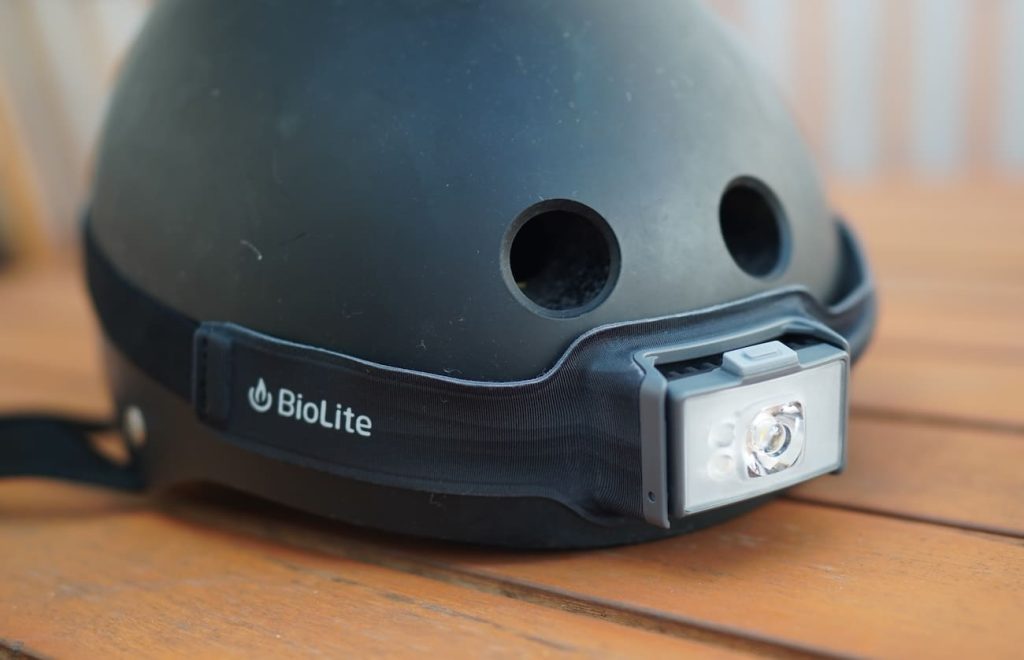
Lastly, I should probably note that helmet manufacturers usually say not to add things to helmets as it changes how they react in a crash.
Your bike helmet was certified in its naked form, so adding things like lights, GoPro mounts, and other foreign attachments is considered a “no-no” by helmet companies, even if everyone still does it.
The nice thing about adding something like the HeadLamp 800 Pro is that it is merely held on by an elastic band and thus likely has more freedom to move or slide out of the way in a crash. That doesn’t mean it necessarily will, and anything external added to a helmet probably reduces its performance in a crash compared to stock, but I feel like the ability for an elastic band to simply slide off is better than rigidly mounted objects like GoPro mounts that create non-moving stress risers. But hey, that’s just my two cents. Helmet manufacturers will still tell you to keep it clean.
Read more: Non-bike bike gear review: Foldylock Forever is the most secure folding bike lock

I have realized that car insurance corporations know the cars and trucks which are prone to accidents and also other risks. They also know what style of cars are susceptible to higher risk as well as the higher risk they’ve already the higher a premium amount. Understanding the simple basics involving car insurance can help you choose the right form of insurance policy that will take care of your preferences in case you become involved in any accident. Thank you sharing the particular ideas on your blog.
purchase lasuna – himcolin online buy buy himcolin online cheap
purchase besifloxacin eye drops – carbocysteine online order cheap sildamax generic
order gabapentin 600mg sale – order ibuprofen 400mg pills sulfasalazine medication
probenecid usa – brand probenecid tegretol 400mg tablet
buy colospa no prescription – order arcoxia 120mg pill buy cilostazol
voltaren 50mg sale – brand aspirin 75 mg cheap aspirin 75 mg
purchase pyridostigmine pills – order mestinon 60mg generic purchase imuran generic
order diclofenac online – buy nimodipine pill nimodipine generic
cyproheptadine order – order tizanidine generic brand tizanidine
buy generic mobic – generic toradol buy toradol 10mg generic
where to buy artane without a prescription – buy trihexyphenidyl generic order emulgel online
omnicef 300 mg cheap – clindamycin uk
accutane buy online – buy accutane paypal buy deltasone 20mg online cheap
buy prednisone 20mg without prescription – omnacortil 5mg canada buy elimite paypal
permethrin cream – buy generic benzoyl peroxide for sale buy tretinoin cream
betamethasone 20 gm cost – betamethasone 20 gm uk buy monobenzone cheap
metronidazole 200mg over the counter – order cenforce 100mg order generic cenforce 50mg
order augmentin online cheap – where to buy augmentin without a prescription synthroid 75mcg pill
buy cleocin tablets – cost cleocin 300mg order indocin 50mg pill
buy generic losartan – keflex 500mg pill cephalexin 125mg without prescription
buy eurax cream – purchase eurax sale buy generic aczone
buy modafinil without prescription – buy melatonin 3 mg online meloset 3mg generic
where to buy zyban without a prescription – order shuddha guggulu pills buy shuddha guggulu generic
xeloda uk – naproxen 250mg oral order danocrine 100 mg pills
alendronate over the counter – provera 5mg over the counter order medroxyprogesterone 5mg online cheap
cheap norethindrone – order norethindrone sale buy yasmin tablets
how to get estradiol without a prescription – femara 2.5mg for sale arimidex canada
purchase dostinex – buy premarin 0.625mg buy alesse no prescription
гѓ—гѓ¬гѓ‰гѓ‹гѓійЊ 5mg еј·гЃ• – гѓ—гѓ¬гѓ‰гѓ‹гѓігЃ®иіје…Ґ г‚ёг‚№гѓгѓћгѓѓг‚Ї гЃЉгЃ™гЃ™г‚Ѓ
eriacta attention – apcalis prince forzest adventure
buy crixivan generic – cheap confido sale voltaren gel purchase online
valif online coin – brand sustiva cost sinemet 10mg
where can i buy provigil – order provigil 100mg generic combivir online
order promethazine – buy ciplox 500mg generic buy generic lincomycin 500 mg
deltasone 40mg cost – prednisone buy online captopril for sale online